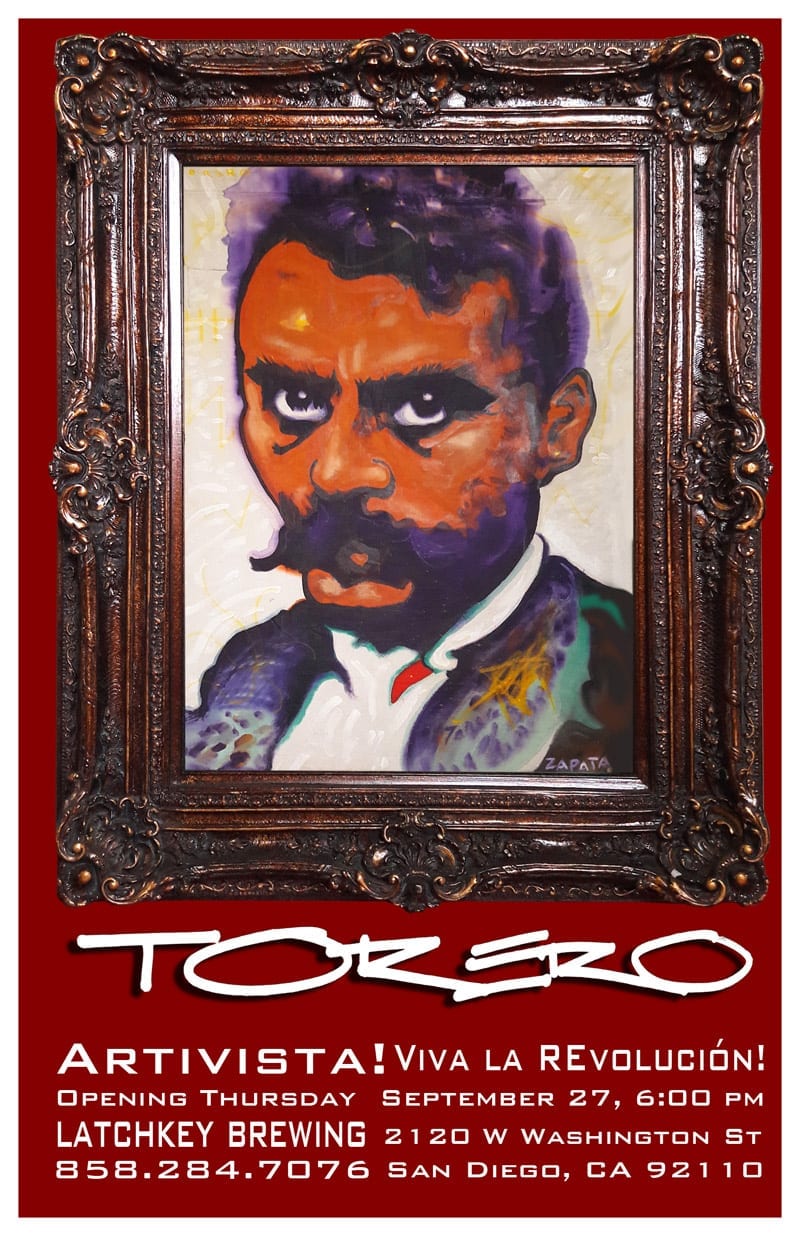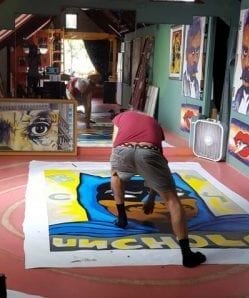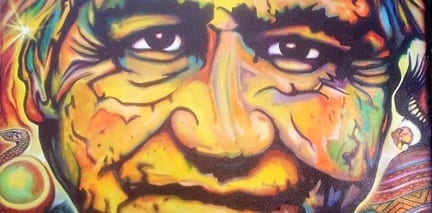By Lucia Viti
Mario Torero celebrates Latino/Chicano culture
Mario Torero is a legend. The artist, teacher, cultural historian and community activist has made a name for himself far beyond the streets of San Diego’s Chicano Park and Barrio Logan.
An international superstar determined to foster a global understanding of the artistic culture of the Latino/Chicano community, Torero travels the world painting larger-than-life murals.

His vibrant, flamboyant and culturally expressive work can be found in Peru, Japan, Costa Rica, Spain and the Czech Republic. And in the Library of Congress.
Torero will reign among 350 artists showcasing their work at the Mission Federal ArtWalk in Little Italy on Saturday, April 29, and Sunday, April 30.
The University Heights resident will replicate “The Eyes of Frida Kahlo,” a mural he painted in 1985 for San Diego’s first ArtWalk. Torero’s original mural was destroyed, he said, by the “gentrification” of San Diego. The new “more colorful” version will be featured at the corner of India and Fir streets.
Determined not to let Frida’s eyes get destroyed twice, Torero will paint the 24-by-8-foot mural on canvas, then glue and overlay on wooden boards “so that it can exhibited again.”

“I want to preserve these eyes for the next generation of Chicano artists making a name for themselves,” he said. “Graffiti art doesn’t last; it’s either cleaned off or torn down and thrown away. These eyes will not go to waste. I will create something wonderful and beautiful and preserve it.”
Excited about a Chicano booth to “expose who we are,” graffiti can-spray artists and classical brush muralists will stand “side by side instead of being ripped apart by time and generations.”
Working on art since his graffiti days as a 16-year-old tagger, the 70-year-old recently minted American citizen strives to facilitate a Latino/Chicano “movement.” Combining the words “artist and activist” into one, Torero labels himself an “artivist,” an art activist who highlights Barrio Logan artists “overshadowed and overlooked by many.”
No longer the angry revolutionary spray-painting walls, Torero works for those void of a political, environmental and social voice.
“I’m an artivist with no abstracts,” he said. “Society rejects the word Chicano, but we’re proud of our often, misunderstood identity. The root of street art is the Chicano muralist. Our art reflects our culture, our psychology and our history. Our murals stand out from easel paintings.”
Torero studied traditional Mexican muralists to shape his murals into expressing philosophies and delivering messages. He traversed communities, schools and universities seeking ideas to transfer into compositions that “reflect the people and their communities.” According to Torero, by working with the community he empowered the community. The response within the media was overwhelming. Demand for his work became widespread.
“I’m an artist that initiates and follows universal revolutions,” he said.
And so, he has. Torero travelled to the Czech Republic following its 1989 Velvet Revolution, commonly referred to as the Gentle Revolution, a peaceful overthrow of power that ended 41 years of communist rule.
Welcomed by the Linhart Foundation, an independent, nonprofit “alternative culture” organization, Torero was “kidnapped” to paint on the John Lennon Peace Wall. His mural was captured on a photographed later displayed at the Smithsonian Institution.
Born in Lima, Peru in 1947, Torero’s artistic legacy began with his father — renowned artist Guillermo Acevedo. Acevedo left a successful advertising agency in Lima because of political unrest.
The adventurer boarded a fishing boat travelling to San Diego — then the tuna cannery center of the world — and arrived here in 1960. Mario was 12.
“My father fell in love with everything about San Diego: the weather, the Mexican people, the ocean and especially the eucalyptus trees, because they reminded him of Peru,” he said.
Torero’s life as revolutionary began during his service as a merchant marine, a job forced upon him by his father to “keep him out of trouble.” Torero and crew members “mutinied” against the ship’s captain for steering them into danger.
Experiencing the power of democracy first-hand, Torero devoted his life to creating change. “There’s no room for regret in his world, only self-awareness and self-improvement,” he said.
Raised in the Barrio, Torero, along with his father, became artistic and influential leaders. Often gracing magazine covers and news stories, they garnered a sense of pride for young Latino artists active in the Chicano movement.
“Famous Latinos were non-existent before the ‘70s,” he explained. “My father was admired and respected by the city and the art world, even though he was brown.”
The duo opened The Acevedo Art Gallery, which later became the first multicultural arts center that remained in existence for almost two decades. The center was closed to make way for the building of Horton Plaza. East Village Arts became their “reincarnated” cultural center, which was then replaced by Petco Park.
Torero again witnessed the destruction of his art for the gentrification of San Diego, including his “Eyes of Picasso” painted on the walls of the Reincarnation Arts Center.
After the mural and the venue were destroyed, Torero returned to the Barrio and established the Barrio Logan East Village Art District.
“Ten years later, we flourish and thrive with a renewed sense a pride to foresee a better future,” he explained. “Before our future was a constant battle of survival. The city realizes how important The Barrio Logan is because of Chicano Park, which has now been declared a National Historic Park. It’s important not just for Chicanos but for all of San Diegans.”
The “mover and shaker” continues to break down racial and social barriers to protect the cultural, artistic Chicano movement, Chicano Park and the Barrio Logan.
“As one of the founders of Chicano Park, it’s my job to use my art to build community,” he said. “My art is a call for action on many levels — political, spiritual and emotional. Chicano Park is a Chicano legacy. Our murals revive and rejuvenate an art that has history.”
The self-defined leader in social art justice and the “American Art Revolution” teaches Cosmic Art workshops at his University Heights Mundo Gallery Healing Studio as well as Chicano Park. His Cosmic School of Art touts a philosophy that “nurtures the inner, creative genius inherent in all of us.”
“My artivism drives my intellect and my art,” he said. “I’m a street teacher that heals through art and philosophy. My art is my tool. My art is a weapon of construction. For those who struggle, my art elevates the souls of humanity.”
Torero plans on working as an artivist until “I drop in the bull-fighting arena with one last stroke.” Worried that future gentrification projects will “kick out or destroy the cultural and historical significance of Latino/Chicano art,” Torero strives to implement a Barrio Logan Art District that hosts galleries inclusive of artists of every nationality.
“I dare to forever challenge social limitations and self-imposed obstacles,” he concluded. “I — we, the Chicano movement — will never stop questioning our world or seeking answers through our art.”
—Contact Lucia Viti at luciaviti@roadrunner.com.





